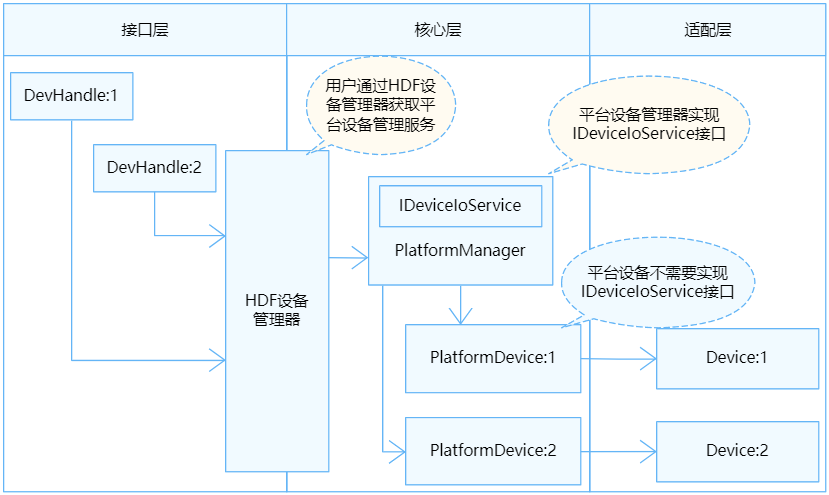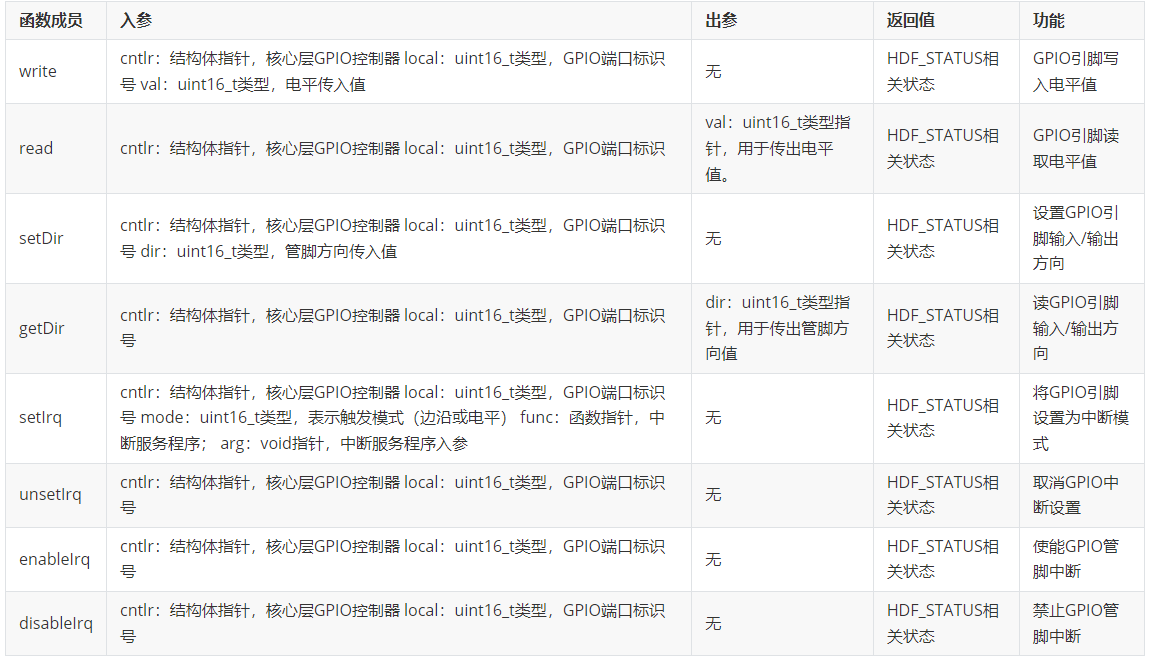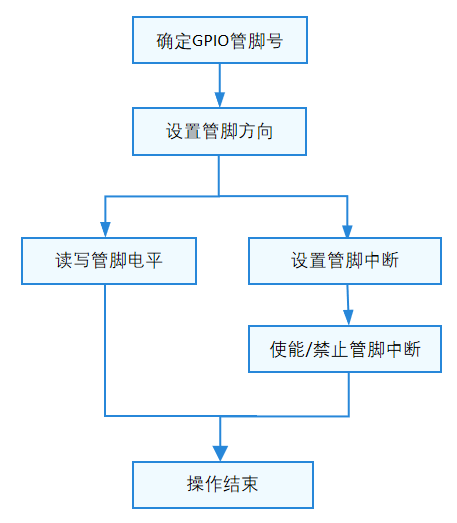[文章]OpenHarmony:全流程讲解如何编写GPIO平台驱动以及应用程序
0
0
1、案例简介
该程序是基于OpenHarmony标准系统编写的基础外设类:GPIO驱动。
目前已在凌蒙派-RK3568开发板跑通。详细资料请参考官网:https://gitee.com/Lockzhiner-Ele ... latform_device_gpio
详细资料请参考OpenHarmony官网:
- GPIO平台驱动开发
- GPIO应用程序开发
2.1、GPIO简介
GPIO(General-purpose input/output)即通用型输入输出。通常,GPIO控制器通过分组的方式管理所有GPIO管脚,每组GPIO有一个或多个寄存器与之关联,通过读写寄存器完成对GPIO管脚的操作。
2.2、GPIO平台驱动GPIO(General-purpose input/output)即通用型输入输出。通常,GPIO控制器通过分组的方式管理所有GPIO管脚,每组GPIO有一个或多个寄存器与之关联,通过读写寄存器完成对GPIO管脚的操作。
GPIO模块各分层作用:
- 接口层提供操作GPIO管脚的标准方法。
- 核心层主要提供GPIO管脚资源匹配,GPIO管脚控制器的添加、移除以及管理的能力,通过钩子函数与适配层交互,供芯片厂家快速接入HDF框架。
- 适配层主要是将钩子函数的功能实例化,实现具体的功能。
GPIO统一服务模式结构图:
为了保证上层在调用GPIO接口时能够正确的操作GPIO管脚,核心层在//drivers/hdf_core/framework/support/platform/include/gpio/gpio_core.h中定义了以下钩子函数,驱动适配者需要在适配层实现这些函数的具体功能,并与钩子函数挂接,从而完成适配层与核心层的交互。
GpioMethod定义:
- struct GpioMethod {
- int32_t (*request)(struct GpioCntlr *cntlr, uint16_t local); // 【预留】
- int32_t (*release)(struct GpioCntlr *cntlr, uint16_t local); // 【预留】
- int32_t (*write)(struct GpioCntlr *cntlr, uint16_t local, uint16_t val);
- int32_t (*read)(struct GpioCntlr *cntlr, uint16_t local, uint16_t *val);
- int32_t (*setDir)(struct GpioCntlr *cntlr, uint16_t local, uint16_t dir);
- int32_t (*getDir)(struct GpioCntlr *cntlr, uint16_t local, uint16_t *dir);
- int32_t (*toIrq)(struct GpioCntlr *cntlr, uint16_t local, uint16_t *irq); // 【预留】
- int32_t (*setIrq)(struct GpioCntlr *cntlr, uint16_t local, uint16_t mode, GpioIrqFunc func, void *arg);
- int32_t (*unsetIrq)(struct GpioCntlr *cntlr, uint16_t local);
- int32_t (*enableIrq)(struct GpioCntlr *cntlr, uint16_t local);
- int32_t (*disableIrq)(struct GpioCntlr *cntlr, uint16_t local);
- }
2.3、GPIO应用程序
GPIO驱动API接口功能:
GPIO标准API通过GPIO管脚号来操作指定管脚,使用GPIO的一般流程如下图所示:
3、代码解析
3.1、准备工作
查看《凌蒙派-RK3568开发板_排针说明表_》(即Git仓库的//docs/board/凌蒙派-RK3568开发板_排针说明表_v1.0.xlsx),选中0_B5(即GPIO0_B5)。
3.2、配置文件
3.2.1、device_info.hcs
创建config/device_info.hcs,用于GPIO驱动设备描述,具体内容如下:
- <p>root {
- device_info {
- platform :: host {
- device_gpio :: device {
- device0 :: deviceNode { // GPIO控制器信息描述
- policy = 2; // 对外发布服务,必须为2,用于定义GPIO管理器的服务
- priority = 50;
- permission = 0644;
- moduleName = "HDF_PLATFORM_GPIO_MANAGER"; // 这与drivers/hdf_core/framework/support/platform/src/gpio/gpio_service.c的g_gpioServiceEntry.moduleName对应,它主要负责GPIO引脚的管理
- serviceName = "HDF_PLATFORM_GPIO_MANAGER";
- }
- device1 :: deviceNode {
- policy = 0; // 等于0,不需要发布服务
- priority = 55; // 驱动驱动优先级
- permission = 0644; // 驱动创建设备节点权限
- moduleName = "linux_gpio_adapter"; // 用于指定驱动名称,必须是linux_adc_adapter,与drivers/hdf_core/adapter/khdf/linux/platform/gpio/gpio_adapter.c对应
- deviceMatchAttr = ""; // 用于配置控制器私有数据,不定义
- }
- }
- }
- }
- }</p><p></p><div class="hljs-center"></div>
device_gpio:为配置树对gpio的设备类结点。
device0:是用于启用HDF_PLATFORM_GPIO_MANAGER驱动的,它负责对GPIO进行对外接口管理。
device1:是用于启用linux_gpio_adapter驱动的,它负责对Linux GPIO的读写(即对Linux Gpio子系统进行操作)。
3.2.3、参与配置树编译
编辑//vendor/lockzhiner/rk3568/hdf_config/khdf/hdf.hcs,将device_info.hcs添加配置树中。具体内容如下所示:
- #include "../../samples/b03_platform_device_gpio/config/device_info.hcs"
3.4、应用程序
3.4.1、gpio_test.c
gpio_test.c主要分为两个部分:
- 对gpio引脚进行读操作。
- 对gpio引脚进行写操作。
(1)对gpio引脚进行读操作
- // GPIO设置为输出
- ret = GpioSetDir(m_gpio_id, GPIO_DIR_OUT);
- if (ret != 0) {
- PRINT_ERROR("GpioSetDir failed and ret = %d\n", ret);
- return -1;
- }
- // GPIO输出电平
- ret = GpioWrite(m_gpio_id, m_gpio_value);
- if (ret != 0) {
- PRINT_ERROR("GpioWrite failed and ret = %d\n", ret);
- return -1;
- }
- // GPIO设置为输出
- ret = GpioSetDir(m_gpio_id, GPIO_DIR_IN);
- if (ret != 0) {
- PRINT_ERROR("GpioSetDir failed and ret = %d\n", ret);
- return -1;
- }
- // 读取GPIO引脚的电平
- ret = GpioRead(m_gpio_id, &m_gpio_value);
- if (ret != 0) {
- PRINT_ERROR("GpioRead failed and ret = %d\n", ret);
- return -1;
- }
- printf("GPIO Read Successful and GPIO = %d, value = %d\n", m_gpio_id, m_gpio_value);
- import("//build/ohos.gni")
- import("//drivers/hdf_core/adapter/uhdf2/uhdf.gni")
- ohos_executable("rk3568_gpio_test") {
- sources = [ "gpio_test.c" ]
- include_dirs = [
- "$hdf_framework_path/include",
- "$hdf_framework_path/include/core",
- "$hdf_framework_path/include/osal",
- "$hdf_framework_path/include/platform",
- "$hdf_framework_path/include/utils",
- "$hdf_uhdf_path/osal/include",
- "$hdf_uhdf_path/ipc/include",
- "//base/hiviewdfx/hilog/interfaces/native/kits/include",
- "//third_party/bounds_checking_function/include",
- ]
- deps = [
- "$hdf_uhdf_path/platform:libhdf_platform",
- "$hdf_uhdf_path/utils:libhdf_utils",
- "//base/hiviewdfx/hilog/interfaces/native/innerkits:libhilog",
- ]
- cflags = [
- "-Wall",
- "-Wextra",
- "-Werror",
- "-Wno-format",
- "-Wno-format-extra-args",
- ]
- part_name = "product_rk3568"
- install_enable = true
- }
编辑//vendor/lockzhiner/rk3568/samples/BUILD.gn,开启sample编译。具体如下:
- "b03_platform_device_gpio/app:rk3568_gpio_test",
建议使用docker编译方法,运行如下:
- hb set -root .
- hb set
- #选择lockzhiner下的rk3568编译分支。
- hb build -f
该程序运行结果如下所示:
- # rk3568_gpio_test -g 13 -i
- gpio id: 13
- gpio dir: in
- gpio value: 0
- GPIO Read Successful and GPIO = 13, value = 1
- #
- #
- # rk3568_gpio_test -g 13 -o
- gpio id: 13
- gpio dir: out
- gpio value: 0
- #
回帖高级模式
声明:本文内容及配图由入驻作者撰写或者入驻合作网站授权转载。文章观点仅代表作者本人,不代表电子发烧友网立场。文章及其配图仅供工程师学习之用,如有内容图片侵权或者其他问题,请联系本站作侵删。 侵权投诉




